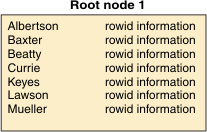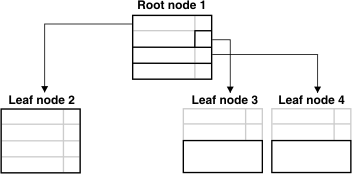Creation of Root and Leaf Nodes
When you create an index for an empty table, the database server allocates a single index page. This page represents the root node and remains empty until you insert data in the table.
At first, the root node functions in the same way as a leaf node. For each
row that you insert into the table, the database server creates and inserts
an index item in the root node. Figure 1 illustrates
how a root node appears before it fills.
Figure 1. Root Node

When the root node becomes full
of index items, the database server splits the root node by performing the
following steps:
- Creates two leaf nodes
- Moves approximately half of the root-node entries to each of the newly created leaf nodes
- Puts pointers to leaf nodes in the root node
As you add new rows to a table, the database server adds index items to the leaf nodes. When a leaf node fills, the database server creates a new leaf node, moves part of the contents of the full index node to the new node, and adds a node pointer to the new leaf node in the root node.
